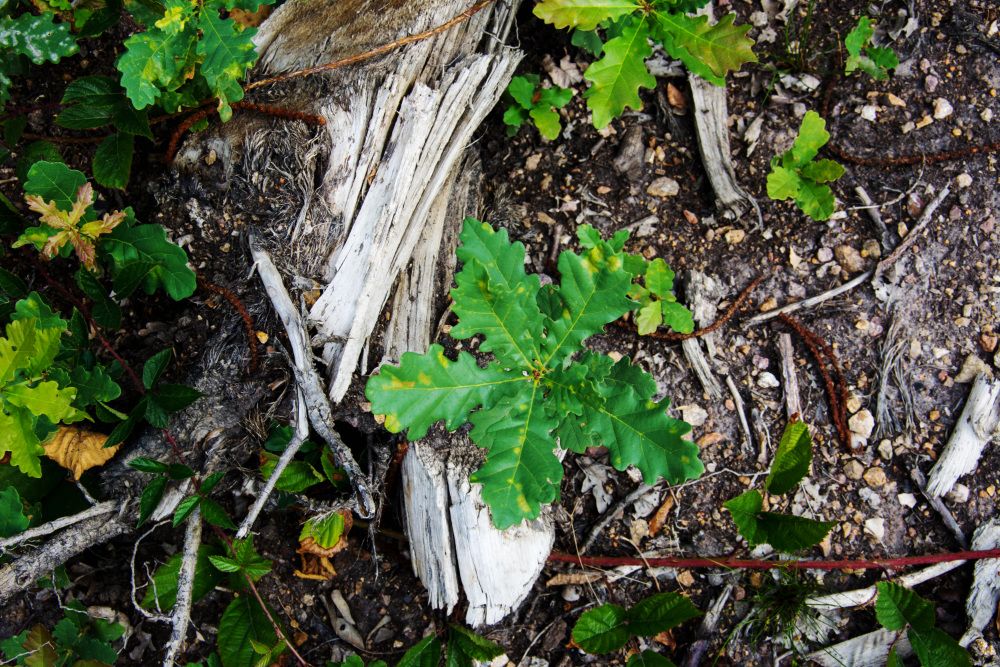Forests can be restored without planting using the Assisted Natural Regeneration (ANR) technique, which is inspired by the dynamics observed in natural forests. As part of a sustainable and gentle forest management approach, ANR meets the goal of multifunctional forest ecosystems, to reconcile their socio-economic (employment, leisure, well-being, etc.) and environmental (carbon storage, biodiversity, etc.) benefits.

The link between ANR and multifunctional forests
In France and in Europe, the management of forests, whether they are mature or suffering from a hazard (storm, drought, etc.), raises the question of renewing the entire plot of land. ANR makes it possible to approach the renewal of these plots in an optimised way, over longer periods of time, via gentler operations.
First, this technique can avoid clear-cutting and exposed soil, favouring the gradual regeneration of the forest and thus preserving the biodiversity and carbon storage function of the soil throughout the process. Second, it enables true multifunctional forests to be created, which provide numerous benefits beyond simply sustaining biodiversity: wood production, carbon storage, water cycle regulation and more.
This makes ANR a formidable eco-friendly approach that allows for the restoration and strengthening of our forest ecosystems.

What is the principle behind Assisted Natural Regeneration? A fair division of labour between forest and forester
Forests naturally give rise to new trees. In spring and summer, the forest ensures the fertilisation of the trees through flowering. Fruits then grow and fall from the tree when they are ripe. The seeds contained in the fruit become lodged in the soil and germinate when the optimal light, temperature and moisture conditions are met. Many small seedlings a few centimetres high can be found at the foot of the tree. However, depending on the size and density of the adult trees overhanging the young shoots, these latter may lack space and light, hindering their optimal growth.
This is where the forester comes in. They will support the forest and help it to regenerate under optimal conditions. Their goal is to encourage good quality young shoots and to give them the light and space they need to thrive. While taking care to maintain minority species in order to conserve forest diversity, work is also carried out to influence the selection of species in favour of those with the highest evolutionary chances and that are best adapted to climate change.
To do this, the forester will carefully observe the forest’s evolution and, over time, carry out a variety of forestry work (clearing, pruning, removal of ageing trees, etc.), which will help to support the most promising shoots. Eventually, depending on the ANR method adopted, these shoots will be able to completely replace the adult stand, without clear-cutting or planting, and will re-establish a young, stable, enduring forest, rich in benefits. Assisted natural regeneration of a forest takes place over a relatively long period of time, requiring about 15 years.
So... ANR involves cutting down trees?
Yes, but in a beneficial and sustainable way! ANR is a gentle forest management technique that is respectful of living things. Humans serve the forest as a whole and support its natural regeneration over time. ANR opposes the principle of clear-cutting, which is catastrophic for the ecosystem and biodiversity.
In an ANR process, adult trees can be partially or totally removed, in the end, depending on the method employed (periodic or sporadic). But in both cases, this is done gently and progressively, while preserving the forest ecosystem. Which method is chosen depends on the health of the mature forest canopy overhanging the seedlings. If most of the trees are older and no longer performing all their ecological functions (such as carbon storage), ‘periodic’ ANR consists of gradually removing all the adult trees (over about 5 years), while the young shoots continue to grow on the plot. If the adult forest cover is healthy, ‘sporadic’ ANR involves sporadically felling certain carefully selected mature trees to allow light through to the undergrowth.
Whatever the method, the trees that are removed continue to play a role (e.g. carbon capture) and contribute to the timber sector, a vital part of the socio-economic landscape and crucial to a sustainable energy transition. This is what a sustainably managed forest is all about.
Does ANR replace planting trees from nurseries?
ANR is a solution that complements planting. Choosing between planting and ANR depends on the type of forest plot. ANR is not possible on land that is not capable of natural regeneration (no seedlings from seeds dropped from adult trees). In addition, some forests require new species of trees to be integrated, so they can adapt to climate change and better cope with droughts and diseases, in particular. In these cases, planting trees from nurseries is necessary. In some cases (e.g. drought-affected forest), however, it is possible to combine ANR with stand enrichment through the planting of diverse species.

Innovation: Reforest’Action supports ANR projects throughout France
At Reforest’Action, the variety of solutions meets the diverse needs of forests, with shared objectives: making forests more resistant and developing their multifunctionality. ANR is thus a perfect fit with Reforest’Action’s environmental and ecological aspirations, as well as those of the foresters with whom we work. Our goal is to support the ANR approach over several years to ensure the proper growth of the selected stands.
Priority is given to ensuring the diversity of tree species represented in the regenerating forest, rather than favouring the regeneration of a single type of tree. Reforest’Action also encourages foresters to leave quantities of dead wood within the plot, so that they can contribute to the development of fauna and flora biodiversity.
Supporting an assisted natural regeneration project with Reforest’Action means:
- Helping to fight climate change and biodiversity loss;
- Helping to recreate multifunctional forests that acknowledge the vital socio-economic aspect;
- Encouraging a virtuous forest management system with a rational, sustainable method that draws on the forest’s natural cycle;
- Protecting and developing carbon and biodiversity sinks for the future by boosting our forest resources for the long term.